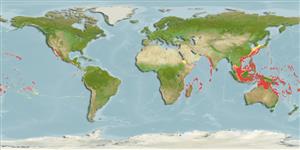Common names from other countries
Environment: milieu / climate zone / depth range / distribution range
Ecología
marino asociado a arrecife; no migratorio; rango de profundidad 1 - 150 m (Ref. 34024). Tropical
Indo-Pacific: East Africa to Hawaii, throughout Micronesia and Amami Islands, southern Japan.
Tamaño / Peso / Age
Maturity: Lm ? range ? - ? cm
Max length : 21.0 cm TL macho / no sexado; (Ref. 30504)
Radios blandos dorsales (total) : 35 - 41; Radios blandos anales: 54 - 61; Vértebra: 102 - 114. Eel-like, moderate to shallow body depth; cardiform teeth present but restricted to upper jaw symphysis; swim bladder constricted (under vertebrae 9 or 10) forming two chambers; lacking enlarged dentary or premaxillary fangs, dentary diastema, pelvic fins and swim bladder rockerbone (Ref. 34024). Differs from Encheliophis homei by possessing scattered melanophores over most of the body (Ref. 37816).
Common species (Ref. 34024). Found in starfishes (mainly) and holothurians (Ref. 4104), usually in a male - female pair (Ref. 11228). Benthic (Ref. 58302). In Micronesia, it prefers the pincushion starfish Culcita novaeguinae for a host. Also known to occur in certain holothurians (Bohadschia argus, Stichopus sp.) on rare occasions (Ref. 1602); for the first time with Isostichopus fuscus along the coast of Ecuador (Ref. 57700).
Life cycle and mating behavior
Maturities | Reproducción | Spawnings | Egg(s) | Fecundities | Larva
Nielsen, J.G., D.M. Cohen, D.F. Markle and C.R. Robins, 1999. Ophidiiform fishes of the world (Order Ophidiiformes). An annotated and illustrated catalogue of pearlfishes, cusk-eels, brotulas and other ophidiiform fishes known to date. FAO Fish. Synop. 125(18):178p. Rome: FAO. (Ref. 34024)
IUCN Red List Status (Ref. 130435)
CITES (Ref. 128078)
Not Evaluated
Threat to humans
Harmless
Human uses
Pesquerías: sin interés
Herramientas
Special reports
Download XML
Fuentes de Internet
Estimates based on models
Preferred temperature (Ref.
115969): 23.6 - 28.9, mean 27.6 (based on 1346 cells).
Phylogenetic diversity index (Ref.
82804): PD
50 = 0.5312 [Uniqueness, from 0.5 = low to 2.0 = high].
Bayesian length-weight: a=0.00102 (0.00046 - 0.00225), b=3.06 (2.88 - 3.24), in cm Total Length, based on all LWR estimates for this body shape (Ref.
93245).
Nivel trófico (Ref.
69278): 3.6 ±0.5 se; based on size and trophs of closest relatives
Fishing Vulnerability (Ref.
59153): Low vulnerability (11 of 100).
